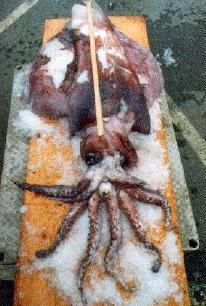 |
How many eggs does a shrimp produce in one spawning?
About 500,000.

How much shrimp is produced in the United States, and where is the largest catch taken?
The annual catch has been running close to 400 million pounds
for several years. The Gulf States usually lead in shrimp catches,
with Texas and Louisiana the leading States. Alaska has been an
important shrimp producer for the past several years. The shrimp
fishery has the highest market value of all U.S. fisheries.
 Shrimp Boat Shrimp Boat
Image Copyright © 1995 - Terrance F. Kasper
What are the commercially important shrimp on the east coast of the United States, and what are their ranges?
Three shrimp species are of primary commercial importance: Pink
shrimp from Chesapeake Bay through the Gulf of Mexico and the West
Indies to Brazil; white shrimp from Fire Island, New York, to Cape
Kennedy, Florida, in the Gulf of Mexico from Pensacola, Florida, to
Campeche, Mexico, in Cuba and Jamaica; brown shrimp from Massachusetts
down the east coast through the Gulf of Mexico, and the West Indies to
Uruguay.
What is the biggest bivalve mollusk, cephalopod mollusk, and
crustacean known to man?
 The biggest bivalve mollusk is the clam Tridacna, native to the
Indo-Pacific, which reaches a weight of 500 pounds. The giant squid, nearly sixty feet long, is the biggest cephalopod. The Alaskan king
crab is the largest of the crustaceans, weighing up to 15 pounds, and
measuring four to five feet across shell and claws.
The biggest bivalve mollusk is the clam Tridacna, native to the
Indo-Pacific, which reaches a weight of 500 pounds. The giant squid, nearly sixty feet long, is the biggest cephalopod. The Alaskan king
crab is the largest of the crustaceans, weighing up to 15 pounds, and
measuring four to five feet across shell and claws.

King Crab, (Crab Photo by Bjørn T. Forberg)
|
What do oysters and clams eat?
Called filter feeders, oysters and clams eat plankton. By
pumping water through their bodies, the mollusks strain the microscopic
organisms through their gills, which act as sieves.
Clams seem to squirt water through their siphons. What purpose does the siphon serve?

|
Three main purposes: breathing, obtaining food, and eliminating
waste products. Since clams are relatively immobile and movement is
usually limited to burrowing in the sand, their double-tubed
siphon--which operates much like a snorkel--is their lifeline.
Inflowing water is pumped through the siphon, passed over the gills,
and strained to remove food particles. After receiving carbon dioxide
from the gills and other waste products from the digestive tract, the
water is expelled through the outgoing siphon. Constant circulation of
the water is maintained by the beating of a multitude of microscopic
hairs (called cilia) located inside the tube and in the gill chamber.
|
What causes a reddish color in the liquor of shucked oysters and clams?
The red algae they sometimes consume, often composed of the
microscopic one-celled dinoflagellates which appear in planktonic
mass.
  
|
 |